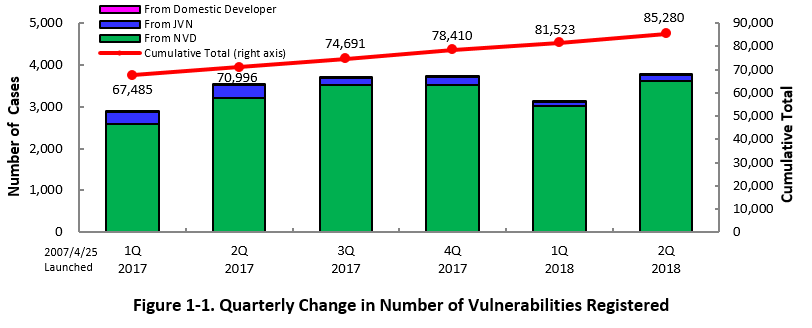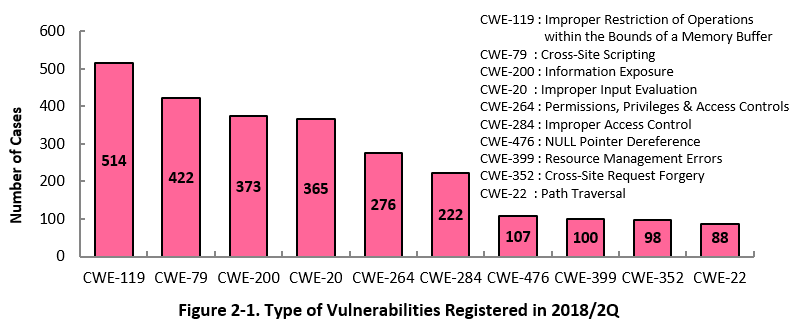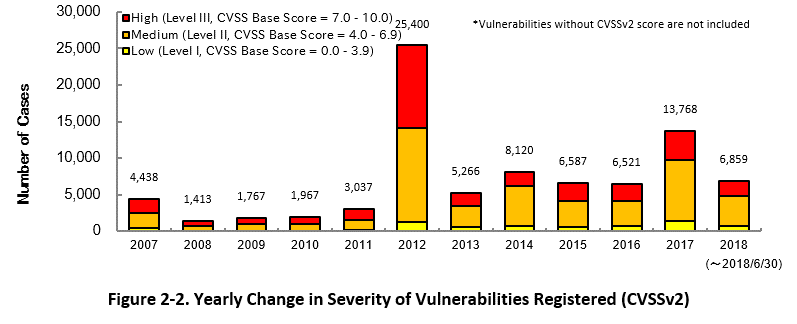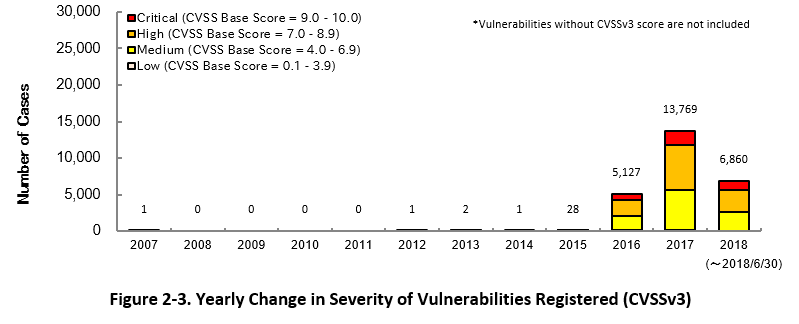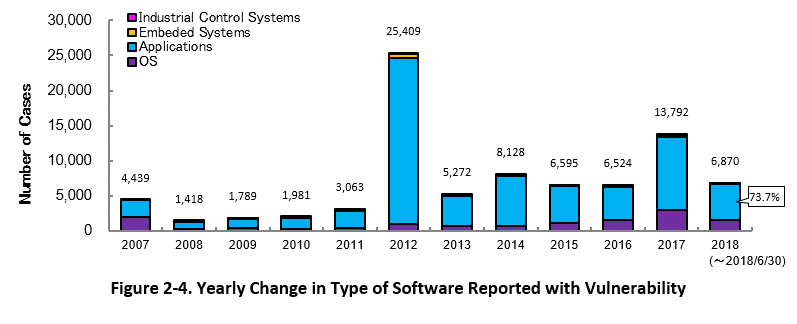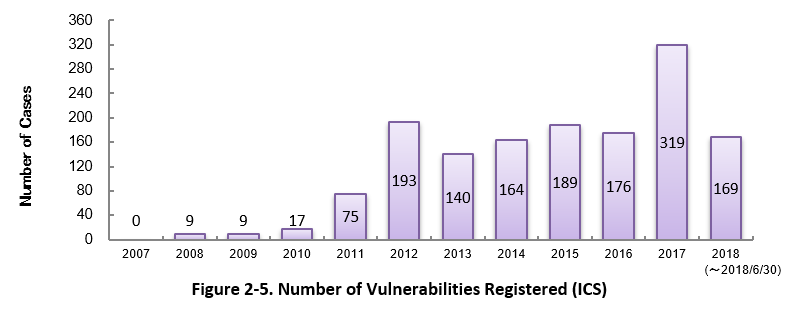Enhancing information security

Vulnerability Countermeasure Information Database JVN iPedia Registration Status [2018 2nd Quarter (Apr. - Jun.)]
Release Date:Aug 30, 2018
IT Security Center
1. 2018 2nd Quarter: Vulnerability Countermeasure Information Database JVN iPedia Registration Status
The vulnerability countermeasure information database JVN iPedia (https://jvndb.jvn.jp/en/) is endeavoring to become a comprehensive vulnerability database where vulnerability information is aggregated for easy access for IT users. JVN iPedia collects and/or translates the vulnerability information published by 1) domestic software developers, 2) JVN (*1), a vulnerability information portal run by JPCERT/CC and IPA, and 3) NVD (*2), a vulnerability database run by NIST (*3). JVN iPedia has been making vulnerability information available to the public since April 25, 2007.
1-1. Vulnerabilities Registered in 2018/2Q
~ JVN iPedia now stores 85,280 vulnerabilities ~
The summary of the vulnerability information registered to the Japanese version of JVN iPedia during the 2nd quarter of 2018 (April 1 to June 30, 2018) is shown in the table below. As of the end of June 2018, the total number of vulnerabilities stored in JVN iPedia is 85,280 (Table 1-1, Figure 1-1).
As for the English version, the total of 1,922 vulnerabilities are available as shown in the lower half of the table.
Table 1-1. Registered Vulnerabilities in 2nd Quarter of 2018
|
|
Information Source
|
Registered Cases
|
Cumulative Cases
|
|---|---|---|---|
|
Japanese Version
|
Domestic Product Developers
|
3 cases
|
201 cases
|
|
JVN
|
146 cases
|
8,099 cases
|
|
|
NVD
|
3,608 cases
|
76,980 cases
|
|
|
Total
|
3,757 cases
|
85,280 cases
|
|
|
English Version
|
Domestic Product Developers
|
3cases
|
201 cases
|
|
JVN
|
38 cases
|
1,721 cases
|
|
|
Total
|
41 cases
|
1,922 cases
|
2. Details on JVN iPedia Registered Data
2-1. Types of Vulnerabilities Reported
Figure 2-1 shows the number of vulnerabilities newly added to JVN iPedia during the 2nd quarter of 2018, sorted by the CWE vulnerability types.
The type of the vulnerabilities reported most in the 2nd quarter is CWE-119 (Improper Restriction of Operations within the Bounds of a Memory Buffer) with 514 cases, followed by CWE-79 (Cross-Site Scripting) with 422, CWE-200 (Information Exposure) with 373, CWE-20 (Improper Input Validation) with 365, CWE-264 (Permissions, Privileges, and Access Controls) with 276. CWE-119, the most reported vulnerability type this quarter, could allow attackers to execute malicious code on the affected servers and PCs, resulting in undesired consequences such as unauthorized access to and modification of data.
Software developers need to make sure to implement necessary security controls from the planning and design phase of software development to mitigate vulnerability. IPA provides tools and guidelines, such as "How to Secure Your Website" (*4), "Secure Programing Guide" (*5) and "AppGoat" (*6), a hands-on venerability learning tool, for website developers and operators to build secure websites.
2-2. Severity of Vulnerabilities Reported
Figure 2-2 shows the yearly change in the CVSSv2 rating scale based severity of vulnerabilities registered to JVN iPedia.
As for the vulnerabilities added to JVN iPedia in 2018, 30.0 percent are "level III" (7.0 - 10.0), 58.7 percent are "level ll" (4.0 – 6.9) and 11.3 percent are "level I" (0.0 – 3.9). This means 88.7 percent of all vulnerabilities registered are level II or higher, which are potentially critical enough to cause damage like information exposure or data modification.
Figure 2-3 shows the yearly change in the CVSSv3 rating scale based severity of vulnerabilities registered to JVN iPedia.
As for the vulnerabilities added to JVN iPedia in 2018, 18.4 percent are "Critical" (9.0 – 10.0), 43.5 percent are "High" (7.0 – 8.9), 36.8 percent are "Medium" (4.0 – 6.9) and 1.3 percent are "Low" (0.1 – 3.9).
To mitigate threats imposed by the known vulnerabilities, IT users should pay close attention to vulnerability information and update software they are using to a fixed version or apply a security patch as soon as possible when they become available. IT users can also check vulnerabilities newly published on JVN iPedia in RSS and XML format (*7) as well.
2-3. Types of Software Reported with Vulnerability
Figure 2-4 shows the yearly change in the type of software reported with vulnerability. Application vulnerabilities have been published most, accounting for 73.7 percent (5,065 out of 6,870) of the 2018 total.
Figure 2-5 shows the yearly change in the number of JVN iPedia-stored vulnerabilities in industrial control systems (ICS) used in critical infrastructure sectors. As of June 2018, the total of 1,460 ICS vulnerabilities have been registered.
2-4. Products Reported with Vulnerability
Table 2-1 lists the top 20 software whose vulnerabilities were most registered to JVN iPedia during the 2nd quarter (April to June) of 2018.
In this quarter, many Android-related vulnerabilities were published. Ranked 1st is Qualcomm processor firmware with 268 vulnerabilities (firmware for all Qualcomm processors including SD and MSM is collectively treated as Qualcomm processor firmware) and ranked 2nd is Android OS with 207 vulnerabilities. The the 3rd and below are mostly OS products and many vulnerabilities in popular products, such as Microsoft's and Apple's, had been registered.
Besides those in the top 20 list, JVN iPedia stores and offers vulnerability information about a variety of software. IPA hopes software developers and users will make good use of JVN iPedia to efficiently check vulnerability information and take necessary action in a timely manner (*8).
Table 2-1. Top 20 Software Products Vulnerabilities Were Most Registered [Apr. – Jun. 2018]
|
Rank
|
Category
|
Product Name (Vendor)
|
Number of
Vulnerabilities Registered |
|---|---|---|---|
|
1
|
Firmware
|
Qualcomm firmware (Qualcomm)
|
268
|
|
2
|
OS
|
Android (Google)
|
207
|
|
3
|
OS
|
Debian GNU/Linux (Debian)
|
171
|
|
4
|
PDF Viewer
|
Foxit Reader (Foxit Software inc.)
|
94
|
|
5
|
PDF Viewer/Editor
|
Foxit PhantomPDF (Foxit Software inc.)
|
89
|
|
6
|
OS
|
iOS (Apple)
|
87
|
|
7
|
OS
|
Ubuntu (Canonical)
|
79
|
|
8
|
OS
|
Microsoft Windows 10 (Microsoft)
|
78
|
|
9
|
OS
|
Microsoft Windows Server 2016 (Microsoft)
|
73
|
|
9
|
OS
|
Apple Mac OS X (Apple)
|
73
|
|
11
|
OS
|
tvOS (Apple)
|
58
|
|
12
|
OS
|
Microsoft Windows 8.1 (Microsoft)
|
56
|
|
13
|
OS
|
Microsoft Windows 7 (Microsoft)
|
55
|
|
14
|
OS
|
Microsoft Windows Server 2012 (Microsoft)
|
54
|
|
15
|
OS
|
Microsoft Windows Server 2008 (Microsoft)
|
53
|
|
16
|
OS
|
Microsoft Windows RT 8.1 (Microsoft)
|
52
|
|
16
|
Backup Software
|
Disk Backup (Quest Software Inc.)
|
52
|
|
18
|
OS
|
Microsoft Windows Server Version 1709 (Microsoft)
|
49
|
|
19
|
OS
|
Linux Kernel (Kernel.org)
|
47
|
|
20
|
OS
|
watchOS (Apple)
|
45
|
3. Most Accessed Vulnerability Countermeasure Information
Table 3-1 lists the top 20 most accessed vulnerability information in JVN iPedia during the 2nd quarter of 2018 (April – June).
Ranked 1st was vulnerability in Spring Security and Spring Framework by Pivotal Software Inc.. Through the affected products/versions, a remote attacker could bypass authentication and steal information. Ranked 2nd is vulnerability in Safari installed in iPhone and Mac, and it may allow an attacker to execute arbitrary scripts on the user's browser via a crafted URL. Ranked 3rd is multiple vulnerabilities in Cybozu Garoon and they may allow an attacker to cause various undesired consequences, such as bypassing access restriction to alter setting data of session authentication.
Table 3-1. Top 20 Most Accessed Vulnerability Countermeasure Information in JVN iPedia [Apr. – Jun. 2018]
No.1 Spring Security and Spring Framework vulnerable to authentication bypass JVNDB-2018-000008
- CVSSv2 Severity Rating Scale
-
Level II (Medium)
- CVSSv2 Base Score
-
5.0
- CVSSv3 Severity Rating Scale
-
Medium
- CVSSv3 Base Score
-
5.3
- Date Public
-
2018/2/2
- Access Count
-
7,870
No.2 Safari vulnerable to script injection JVNDB-2018-000029
- CVSSv2 Severity Rating Scale
-
Level II (Medium)
- CVSSv2 Base Score
-
5.8
- CVSSv3 Severity Rating Scale
-
Medium
- CVSSv3 Base Score
-
5.4
- Date Public
-
2018/3/30
- Access Count
-
6,629
No.3 Multiple vulnerabilities in Cybozu Garoon JVNDB-2018-000031
- CVSSv2 Severity Rating Scale
-
Level II (Medium)
- CVSSv2 Base Score
-
5.5
- CVSSv3 Severity Rating Scale
-
Medium
- CVSSv3 Base Score
-
5.4
- Date Public
-
2018/4/9
- Access Count
-
6,451
No.4 Installer of SoundEngine Free may insecurely load Dynamic Link Libraries JVNDB-2018-000030
- CVSSv2 Severity Rating Scale
-
Level II (Medium)
- CVSSv2 Base Score
-
6.8
- CVSSv3 Severity Rating Scale
-
High
- CVSSv3 Base Score
-
7.8
- Date Public
-
2018/4/13
- Access Count
-
6,399
No5. DoS Vulnerability in JP1/ServerConductor/Deployment Manager and Hitachi Compute Systems Manager JVNDB-2018-002257
- CVSSv2 Severity Rating Scale
-
Level III (High)
- CVSSv2 Base Score
-
7.8
- CVSSv3 Severity Rating Scale
-
High
- CVSSv3 Base Score
-
7.5
- Date Public
-
2018/4/4
- Access Count
-
6,382
No.6 Multiple vulnerabilities in WZR-1750DHP2 JVNDB-2018-000027
- CVSSv2 Severity Rating Scale
-
Level III (High)
- CVSSv2 Base Score
-
8.3
- CVSSv3 Severity Rating Scale
-
High
- CVSSv3 Base Score
-
8.8
- Date Public
-
2018/3/29
- Access Count
-
6,199
No.7 Tenable Appliance vulnerable to cross-site scripting JVNDB-2018-000034
- CVSSv2 Severity Rating Scale
-
Level II (Medium)
- CVSSv2 Base Score
-
4.0
- CVSSv3 Severity Rating Scale
-
Medium
- CVSSv3 Base Score
-
5.4
- Date Public
-
2018/4/12
- Access Count
-
6,016
No.8 LXR vulnerable to OS command injection JVNDB-2018-000028
- CVSSv2 Severity Rating Scale
-
Level III (High)
- CVSSv2 Base Score
-
7.5
- CVSSv3 Severity Rating Scale
-
Critical
- CVSSv3 Base Score
-
9.8
- Date Public
-
2018/3/29
- Access Count
-
5,962
No.9 Lhaplus vulnerable to improper verification when expanding ZIP64 archives JVNDB-2018-000001
- CVSSv2 Severity Rating Scale
-
Level II (Medium)
- CVSSv2 Base Score
-
4.3
- CVSSv3 Severity Rating Scale
-
Low
- CVSSv3 Base Score
-
3.3
- Date Public
-
2018/1/11
- Access Count
-
5,949
No.10 WordPress plugin "Open Graph for Facebook, Google+ and Twitter Card Tags" vulnerable to cross-site scripting JVNDB-2018-000040
- CVSSv2 Severity Rating Scale
-
Level I (Low)
- CVSSv2 Base Score
-
2.6
- CVSSv3 Severity Rating Scale
-
Medium
- CVSSv3 Base Score
-
6.1
- Date Public
-
2018/4/27
- Access Count
-
5,642
No.11 The installer of PhishWall Client Internet Explorer edition may insecurely load Dynamic Link Libraries JVNDB-2018-000033
- CVSSv2 Severity Rating Scale
-
Level II (Medium)
- CVSSv2 Base Score
-
6.8
- CVSSv3 Severity Rating Scale
-
High
- CVSSv3 Base Score
-
7.8
- Date Public
-
2018/4/12
- Access Count
-
5,634
No.12 Insecure DLL Loading issue in multiple Trend Micro products JVNDB-2018-000013
- CVSSv2 Severity Rating Scale
-
Level II (Medium)
- CVSSv2 Base Score
-
6.8
- CVSSv3 Severity Rating Scale
-
High
- CVSSv3 Base Score
-
7.8
- Date Public
-
2018/2/15
- Access Count
-
5,595
No.13 EC-CUBE vulnerable to session fixation JVNDB-2018-000035
- CVSSv2 Severity Rating Scale
-
Level II (Medium)
- CVSSv2 Base Score
-
5.8
- CVSSv3 Severity Rating Scale
-
Medium
- CVSSv3 Base Score
-
4.2
- Date Public
-
2018/4/17
- Access Count
-
5,559
No.14 The installers of multiple CELSYS,Inc. software may insecurely load Dynamic Link Libraries JVNDB-2018-000041
- CVSSv2 Severity Rating Scale
-
Level II (Medium)
- CVSSv2 Base Score
-
6.8
- CVSSv3 Severity Rating Scale
-
High
- CVSSv3 Base Score
-
7.8
- Date Public
-
2018/4/27
- Access Count
-
5,509
No.15 iRemoconWiFi App for Android fails to verify SSL server certificates JVNDB-2018-000026
- CVSSv2 Severity Rating Scale
-
Level II (Medium)
- CVSSv2 Base Score
-
4.0
- CVSSv3 Severity Rating Scale
-
Medium
- CVSSv3 Base Score
-
4.8
- Date Public
-
2018/3/27
- Access Count
-
5,453
No.16 WordPress plugin "Events Manager" vulnerable to cross-site scripting JVNDB-2018-000037
- CVSSv2 Severity Rating Scale
-
Level I (Low)
- CVSSv2 Base Score
-
3.5
- CVSSv3 Severity Rating Scale
-
Medium
- CVSSv3 Base Score
-
5.4
- Date Public
-
2018/4/27
- Access Count
-
5,416
No.17 WordPress plugin "WP Google Map Plugin" vulnerable to cross-site scripting JVNDB-2018-000038
- CVSSv2 Severity Rating Scale
-
Level I (Low)
- CVSSv2 Base Score
-
2.6
- CVSSv3 Severity Rating Scale
-
Medium
- CVSSv3 Base Score
-
6.1
- Date Public
-
2018/4/27
- Access Count
-
5,398
No.18 Hatena Bookmark App for iOS contains an address bar spoofing vulnerability JVNDB-2018-000032
- CVSSv2 Severity Rating Scale
-
Level I (Low)
- CVSSv2 Base Score
-
2.6
- CVSSv3 Severity Rating Scale
-
Low
- CVSSv3 Base Score
-
3.1
- Date Public
-
2018/4/10
- Access Count
-
5,366
No.19 WebProxy vulnerable to directory traversal JVNDB-2018-000908
- CVSSv2 Severity Rating Scale
-
Level III (High)
- CVSSv2 Base Score
-
7.5
- CVSSv3 Severity Rating Scale
-
High
- CVSSv3 Base Score
-
7.3
- Date Public
-
2018/3/13
- Access Count
-
5,358
No.20 WordPress plugin "PixelYourSite" vulnerable to cross-site scripting JVNDB-2018-000039
- CVSSv2 Severity Rating Scale
-
Level I (Low)
- CVSSv2 Base Score
-
2.6
- CVSSv3 Severity Rating Scale
-
Medium
- CVSSv3 Base Score
-
6.1
- Date Public
-
2018/4/27
- Access Count
-
5,333
Table 3-2 lists the top 5 most accessed vulnerability information among those reported by domestic product developers.
Table 3-2. Top 5 Most Accessed Vulnerabilities Reported by Domestic Developers [Apr. - Jun. 2018]
No.1 DoS Vulnerability in JP1/ServerConductor/Deployment Manager and Hitachi Compute Systems Manager JVNDB-2018-002257
- CVSSv3 Severity Rating Scale
-
Level III (High)
- CVSSv2 Base Score
-
7.8
- CVSSv3 Severity Rating Scale
-
High
- CVSSv3 Base Score
-
7.5
- Date Public
-
2018/4/4
- Access Count
-
6,382
No.2 Vulnerability in Cosminexus HTTP Server and Hitachi Web Server JVNDB-2016-008607
- CVSSv2 Severity Rating Scale
-
Level II (Medium)
- CVSSv2 Base Score
-
4.3
- CVSSv3 Severity Rating Scale
-
Medium
- CVSSv3 Base Score
-
4.0
- Date Public
-
2017/6/26
- Access Count
-
4,891
No.3 XXE Vulnerability in Hitachi Device Manager JVNDB-2018-001389
- CVSSv2 Severity Rating Scale
-
Level III (High)
- CVSSv2 Base Score
-
7.8
- CVSSv3 Severity Rating Scale
-
High
- CVSSv3 Base Score
-
7.4
- Date Public
-
2018/2/14
- Access Count
-
4,310
No.4 Cross-site Scripting Vulnerability in Fujitsu Interstage List Works JVNDB-2017-004687
- CVSSv2 Severity Rating Scale
-
Level II (Medium)
- CVSSv2 Base Score
-
4.3
- CVSSv3 Severity Rating Scale
-
Medium
- CVSSv3 Base Score
-
6.1
- Date Public
-
2017/7/5
- Access Count
-
4,181
No.5 Cross-site Scripting Vulnerability in multiple Hitachi products JVNDB-2017-002225
- CVSSv2 Severity Rating Scale
-
Level II (Medium)
- CVSSv2 Base Score
-
4.3
- CVSSv3 Severity Rating Scale
-
Medium
- CVSSv3 Base Score
-
4.7
- Date Public
-
2017/4/5
- Access Count
-
4,177
Footnotes
-
(*1)
-
(*2)
-
(*3)
-
(*4)
-
(*5)
-
(*6)
-
(*7)
-
(*8)
Past Quarterly Reports
Contact information
IT Security Center, Information-technology Promotion Agency, Japan (ISEC/IPA)

